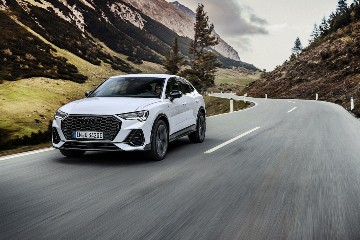What Is It?
It’s the Jeep Wrangler, something which can trace its lineage back to one of the most iconic automotive creations of them all: the 1941 Willys Jeep of World War 2. Although the nameplate has only been in service for 4 generations of rough, tough 4x4 since 1986, the original Wrangler from nearly 40 years ago was a direct replacement for the ‘CJ’ generations of Jeep – and those went right the way back to 1945, which was the first year that a ‘civilian’ version of the Willys army machine was offered; CJ standing for ‘civilian Jeep’, you see.
So, to that end, while it has smoothed-off and appealing lines in the 2020s, the Mk4 Wrangler (which launched in 2017) still wears many of the hallmarks of the original military vehicle – like a barred radiator grille framed by round headlights, and the overall set-square shape of the thing, and the chunky tyres, and the ability to take the roof and even the doors off to drive around in open-air fashion.
That versatility of body, plus its rugged 4-wheel-drive underpinnings – the Jeep is emphatically no road-biased SUV – makes the Wrangler unlike anything else even remotely comparable at the same sort of price. Until it was updated into the all-new model in 2019, a Land Rover Defender was an alternative, while the long-serving Mercedes G-Class offers similar attributes as well – but both of these vehicles are these days considerably more expensive and deliberately upmarket than the Wrangler. Going the other way, the Suzuki Jimny might once have been considered a shrunken Jeep Wrangler, but it is no longer on sale as a civilian vehicle, now only being offered as a 2-seater commercial van.
But does being top of a class of 1 mean you should consider the Jeep Wrangler? Well, to find out, we borrowed an updated 2022 model year 4-door (long-wheelbase) version – complete with changes brought in during 2021 – in full-on, off-road-biased Rubicon specification. Complete with an aftermarket pop-up tent on the roof, as well, just for good measure.
What’s Good About It?
It’s hard to ignore the immense feelgood factor a Jeep Wrangler gives you, even if you’re driving it with all of its body panels and apertures fixed in place. As a Rubicon, it sits miles off the road, even more so than most SUVs, so that simply climbing up into the driver’s seat becomes something of an occasion – even if you’re of average height or more. It’s then riddled with little Jeep graphics and logos to make you smile, such as one climbing up the side of the windscreen and another on the gearlever. In short, the Wrangler imparts a sense of fun into proceedings every time you clamber into it, which is something precious few SUVs of similar size and money can achieve.
What Could Be Better?
Well for starters, there’s no footrest for your left leg, so on long journeys it can become uncomfortable. The seats feel oddly unsupportive and slightly as if they’re trying to tip you forwards off them. At speed, there’s a heck of a lot of wind noise from the Jeep’s cuboid shape, while the Wrangler Rubicon’s 32-inch off-road tyres generate plenty of chatter on the motorway. There’s only 1 engine choice, a 272hp petrol, and it’s criminally thirsty no matter how you drive the Wrangler. For such a big vehicle, it’s not as roomy onboard as you might imagine. The lower half of the 2-piece boot doors is side-hinged in daft fashion, which means you need to leave a LOT of space behind the vehicle if you want to fully open up the cargo area. The steering is particularly loose and slow-witted, especially by current standards.
Yup, there’s plenty to pick nits at, all of which we’ll go into further detail on – and mitigation for – below. And we haven’t even touched on price either, because while the Wrangler might be considerably cheaper than the only 2 vaguely comparable rivals in the form of the Land Rover Defender and Mercedes G-Class, it’s still not what you’d call affordable. Even the 2-door costs more than £55,000 and the 4-door in Rubicon form is the wrong side of £60,000, all of which translates into monthly leasing costs of around £800-£850pcm. However, as we will try and convince you, despite the fact you know there’s plenty wrong with the Wrangler, you still end up… kind of loving it, nonetheless.
What’s It Like To Drive?
Mechanically, the Wrangler is a pretty heavy-duty machine. As a Rubicon, it has front and rear electronically controlled differentials, it has a low-range transfer ‘box, it has a Rock-Trac 4x4 system with an exclusive Off-Road+ mode, it has mud-optimised 32-inch tyres on 17-inch alloys, and its front anti-roll bar can be disconnected for improved rough-roading prowess. What we’re trying to say here is that there is precious little available in any other automotive manufacturers’ showroom, anywhere, that will get you further into the wilderness than a Wrangler Rubicon. It is a serious piece of 4x4 kit.
The pay-off for that is that prioritising off-road capability comes at the expense of on-road refinement. Now, with Mark having driven the shorter-wheelbase for our video review and this test conducted on the longer 4-door version (it has 5 doors, really, as you can access the passenger compartment of the Wrangler through the boot, but Jeep refers to its 2 versions as the 2- and 4-door models so we’ll go with that), we can say that the bigger model has more stability at speed. It feels a more comfortable riding, less wayward machine than the short-wheelbase 2-door.
That said, the Wrangler provides a drive unlike any ‘monocoque’-chassised SUV (i.e., a more road-biased 4-wheel-drive vehicle where the body and platform form a single piece). Instead, the Jeep leans a lot on its soft, long-travel suspension, with plenty of pitch and dive when you are either accelerating fast or braking hard. The steering, as we’ve said, requires plenty of lock to get the front end of the Rubicon to respond, while travelling along the motorway you’ll find you’re making plenty of small corrections at the wheel to keep the Jeep in a straight line. The best way of describing it is that the high-sided Wrangler always feels like you’re driving it in a fairly strong crosswind, although this sensation may well have been exacerbated by the top-heaviness brought on by the aftermarket tent up top on our test car.
In its defence, though, there’s tonnes of grip, good traction from the 4-wheel-drive system and, actually, a very decent 8-speed automatic that makes the most of the 2.0-litre, 4-cylinder turbocharged petrol engine’s outputs of 272hp and 400Nm. Without saying the Wrangler Rubicon is quick, as no 0-62mph is officially quoted and its top speed is 99mph, it feels plenty muscular enough thanks to the quick-responding gearbox and strong midrange urge. The 4-cylinder unit doesn’t even sound too bad, either, unless you rev it right out, whereupon it gets a little breathless and harsh in tone.
And once you’ve cut through the wind noise blustering around the A-pillars, the rumble of the off-road rubber and the mild discomfort you’ll get from not being able to stretch out your clutch leg plus pushing back against the sensation of being tipped out of your seat, you suddenly realise that the Jeep is genuinely fine for longer-distance driving. Sure, there are far better motorway cars, but with its adaptive cruise control and soft suspension, this is a machine that can eat up the miles with reasonably good grace. Or, put another way, the Wrangler isn’t as demanding and tiring to drive as you might expect it to be. You could definitely live with its idiosyncratic manners, in our opinion.
How Practical Is It?
For something so big, the Wrangler Rubicon is not as practical as it could be. Space in the 2nd row is adequate rather than amazing, and while there are 2 cupholders in the transmission tunnel and a large central cubby under the front armrest, the glovebox isn’t the biggest item in the world while the door pockets are nothing more than some nets tacked to the door cards.
Behind the passenger compartment is a 548-litre boot, which is only about as big as what you’d get in a BMW X3, an SUV which is considerably physically smaller than this giant 4x4. The boot is also an odd shape and, as already stated, accessed by a hatch in which the bottom door is side-hinged, so it opens a long way behind the rear bumper when you’re parked. That’s not a helpful feature when you’ve backed into a space in a multistorey car park, especially as the Wrangler Rubicon 4-door is a very long vehicle in the first place. Furthermore, fold the rear seats down and Jeep only claims 1059 litres of cargo capacity, which is about the figure you’d expect if you dropped the back row in a supermini the size of a Renault Clio these days.
Nevertheless, there are ‘hidden’ practicalities with the Wrangler Rubicon, because it is ready-made to get you through the worst of winter snow, come what may, and its roof rails plus its ability to haul up to 2.5 tonnes of braked trailer make it useful in ways beyond it having multiple places to store or charge an iPhone inside the cabin.
How Much Will It Cost Me?
With an official economy figure of 23.7mpg and CO2 emissions of 269g/km, the Jeep Wrangler Rubicon is not going to be a cheap vehicle to run. Indeed, we couldn’t coax more than 30mpg out of it, even on a long, steady motorway run (again, blame the roof-top tent for damaging figures here), and it’ll dip well into the teens if you start demanding a lot of the 2.0-litre petrol engine. It’s also, as we’ve said, expensive to lease/buy, but at least there’s plenty of equipment for your outlay – including an 8.4-inch Uconnect infotainment screen, adaptive cruise control, a 9-speaker premium Alpine audio system, climate control, leather upholstery, heated front seats and a heated steering wheel, keyless entry and go, a reversing camera with parking sensors all round, and much, much more besides.
Anything Else I Should Know?
The Wrangler Rubicon used to be available with a 2.2-litre turbodiesel engine, which was considerably more economical than the 2.0-litre petrol that is now the sole choice. However, after the facelift in 2021, which was the 80th anniversary of the Jeep legend (seeing as the Willys appeared in 1941), only the petrol unit is now available.
What Alternatives Should I Look At?
Ford Ranger Leasing
A good pick-up like the Ranger drives a lot like the Wrangler and is equally talented off-road.
Land Rover Defender Leasing
A far more urbane and expensive thing now in its 2nd generation, but still a formidable 4x4
Mercedes-Benz G-Class
Luxury boxiness with a super-luxury price-tag – especially as the mad V8-powered AMG G63 version.
The Vanarama Verdict: 7/10
"It’s hard to ignore the immense feelgood factor a Jeep Wrangler gives you..."
3 Things To Remember About The Jeep Wrangler Rubicon:
-
Incredibly charismatic
-
Nothing will beat it off-road
-
Several compromises to be made in owning it
For more articles, you can check out our car features and guides section. Or if you're looking for a brand new vehicle, we've got a huge range of cars to lease at unbeatable prices.



